Shield Detail
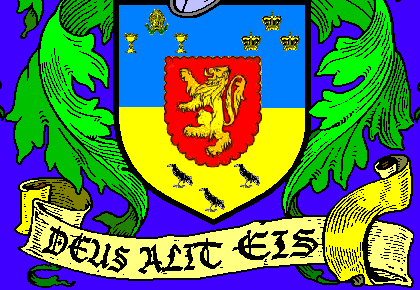
THE SCROLL LEGEND (THE RHYS FAMILY MOTTO)
DEUS ALIT EIS (Latin) — God feeds them — An obvious allusion to the Body and Blood of Jesus Christ, really and truly present, Body, Blood, Soul, and Divinity in the Most Blessed Sacrament of the Altar. Additionally, it shows a family tradition of trustful reliance on Divine Providence for all the family’s needs in good times and in bad.
THE SHIELD’S BACKGROUND
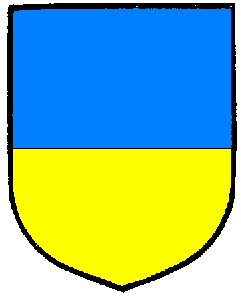
![]()
The shield’s background is divided into two regions, one turquoise, the other gold. The turquoise background honors the Blessed Virgin Mary, recalling the same honor bestowed on her by (possibly) the most honored Rhys ancestor, Arthur Pendragon, the same being King Arthur of song and legend. The gold background honors the whole royal line of Rhys, and was the background adopted by the Tudor family branch of the Rhys family, discussed next.
THE SHIELD’S BLAZONS (IMAGES SUPERIMPOSED ON THE BACKGROUND)
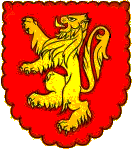
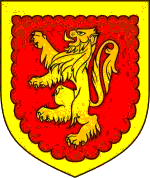
![]()
Owain ap Hywel adopted the gold lion on a red engrailed background in 860 A. D. Rhys ab Tewdwr II in 1060 adopted Owain’s standard, but placed a gold background on which was superimposed Owain’s shield. The lion is the icon of royalty.


![]()
The three royal crowns sparkling on a turquoise background (top right corner of the shield) commemorate the three royal crowns that emblazoned the arms of King Arthur. The turquoise background of King Arthur’s shield recalls the mantle of the Blessed Virgin Mary, to whom Arthur dedicated his reign.

The shimmering bishop’s mitre and two chalices for priestly use in the Divine Liturgy (top left corner of the shield) refer to the fact that the Rhys family gave many priests, bishops, and saints to the early Welsh church — which was, of course, thoroughly Catholic.
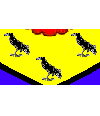
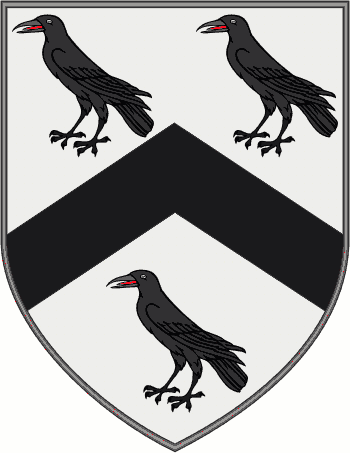
The Rhys family of Dynever (English Denver), Lliw Valley District, Wales to this day bears the emblem of three ravens on their arms. In Celtic countries, the raven (a member of the crow family) was believed to be wise and able to restore sight. Ravens deserting their nests were very bad omens and popular superstition declared that if the ravens ever fled the Tower of London, the monarchy would fall.
![]() Among Catholics, the raven is a symbol for solitude and an attribute of several saints whom ravens fed in the wilderness, including St. Anthony of the Desert, St. Paul the Hermit, and St. Benedict. Although the raven itself is considered unclean by Jews, nonetheless God sent ravens to feed Elijah the Tishbite by the brook Cherith during a long drought. [1 Kings 17:6; Leviticus 11:15; Deuteronomy 14:14]. The raven has long been a symbol of divine providence. [Psalm 147:9; Job 38:41]. Many remember the Lord's command to consider the sparrow and the lilies, but the words, “Consider the ravens, for they neither sow nor reap, which have neither storehouse nor barn; and God feeds them,” are seldom brought to mind. [Luke 12:24]. In the Song of Solomon, the Beloved's locks are “black as a raven.” [Song of Songs 5:11].
Among Catholics, the raven is a symbol for solitude and an attribute of several saints whom ravens fed in the wilderness, including St. Anthony of the Desert, St. Paul the Hermit, and St. Benedict. Although the raven itself is considered unclean by Jews, nonetheless God sent ravens to feed Elijah the Tishbite by the brook Cherith during a long drought. [1 Kings 17:6; Leviticus 11:15; Deuteronomy 14:14]. The raven has long been a symbol of divine providence. [Psalm 147:9; Job 38:41]. Many remember the Lord's command to consider the sparrow and the lilies, but the words, “Consider the ravens, for they neither sow nor reap, which have neither storehouse nor barn; and God feeds them,” are seldom brought to mind. [Luke 12:24]. In the Song of Solomon, the Beloved's locks are “black as a raven.” [Song of Songs 5:11].
![]() The raven symbolizes filial gratitude and affection, wisdom, hope, longevity, and fertility. It represents change, conversion of heart, and the holy soul dying to this world.
The raven symbolizes filial gratitude and affection, wisdom, hope, longevity, and fertility. It represents change, conversion of heart, and the holy soul dying to this world.
![]() Christians consider the raven an emblem of the Virgin Mary. The words, “I am dark, but lovely . . . because the sun has tanned me,” are believed to mean that the light or love of God has so shown upon her that she is burned and purified as if by a mighty sun or fire. [Song of Songs 1:5-6].
Christians consider the raven an emblem of the Virgin Mary. The words, “I am dark, but lovely . . . because the sun has tanned me,” are believed to mean that the light or love of God has so shown upon her that she is burned and purified as if by a mighty sun or fire. [Song of Songs 1:5-6].
![]() These verses also make the raven a symbol of the Church which says, “Do not look upon me (with scorn), because I am dark, because the sun has tanned me. My mother’s sons were angry with me; they made me the keeper of the vineyards, but my own vineyard I have not kept.” [Song of Songs 1:6 (parenthesis added)]. These verses are interpreted by the Church as a plea that potential converts not be discouraged by the sight of a sinful, suffering, harassed, or persecuted Church, but instead realize that the Refiner's fire and forgiveness has made her darkness more beautiful than the virginal purity implied by the whiteness of a dove. The Blessed Virgin Mary is exemplar par excellence of the Church, so these words apply equally to her and to the Church.
These verses also make the raven a symbol of the Church which says, “Do not look upon me (with scorn), because I am dark, because the sun has tanned me. My mother’s sons were angry with me; they made me the keeper of the vineyards, but my own vineyard I have not kept.” [Song of Songs 1:6 (parenthesis added)]. These verses are interpreted by the Church as a plea that potential converts not be discouraged by the sight of a sinful, suffering, harassed, or persecuted Church, but instead realize that the Refiner's fire and forgiveness has made her darkness more beautiful than the virginal purity implied by the whiteness of a dove. The Blessed Virgin Mary is exemplar par excellence of the Church, so these words apply equally to her and to the Church.
Full View of the Rhys Coat-of-Arms
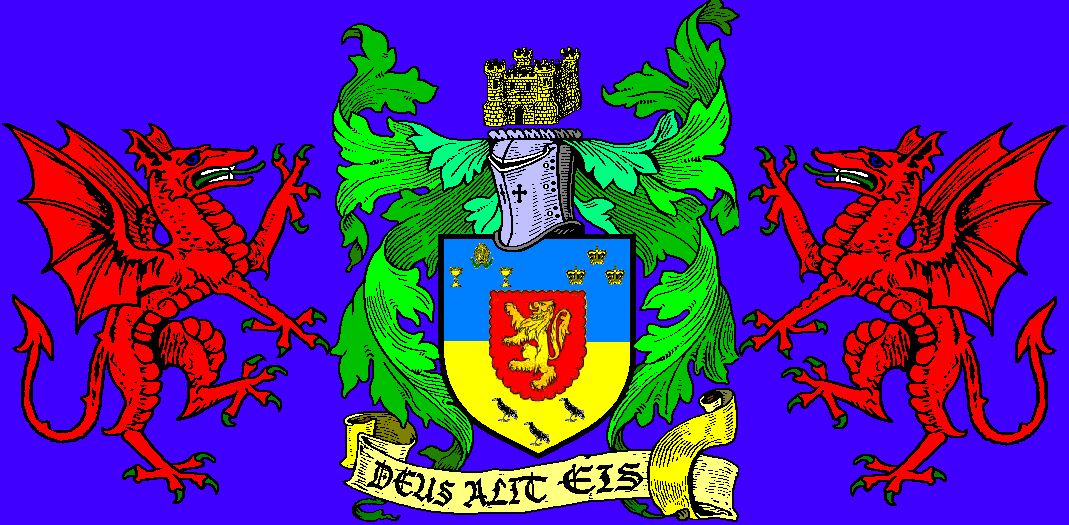
![]() The Rhys family shield is supported by the Tree of Life, which grows, flourishes, and nourishes the faithful in the middle of the Garden of God [Genesis 2:9; Genesis 3:22; Genesis 3:24; Revelation 2:7; Revelation 22:2; Revelation 22:14; Revelation 22:19; and many others]. The Bible likens the just and holy person to the Tree of Life [Proverbs 3:18; Proverbs 11:20; Proverbs 13:12; Proverbs 15:4; and many others].
The Rhys family shield is supported by the Tree of Life, which grows, flourishes, and nourishes the faithful in the middle of the Garden of God [Genesis 2:9; Genesis 3:22; Genesis 3:24; Revelation 2:7; Revelation 22:2; Revelation 22:14; Revelation 22:19; and many others]. The Bible likens the just and holy person to the Tree of Life [Proverbs 3:18; Proverbs 11:20; Proverbs 13:12; Proverbs 15:4; and many others].
![]() The red dragons rampant that flank the Tree of Life are emblems of the civic authority of the State of Wales and of its national “established” church, the Church of England. These dragons necessarily stand outside the Tree of Life which supports and protects the shield, and are prevented by the Tree of Life from directly touching the shield. The imagery speaks for itself. On one hand, it speaks of the long-standing (nearly a millennium) historical prerogatives of civil government which the Rhys family exercised before the reign of Henry Tudor VIII (himself a Rhys) usurped the rightful heirs and appropriated the crown of Wales under the title “Prince of Wales” — and launched the Protestant Revolt. On the other hand, it asserts that this mere human artifice of the Crown of England is incapable of suppressing the truth of the matter. For their public assertions against their kinsman, the Rhys family were forced by him to flee into involuntary exile from Wales under the pressures of heavy persecution and bloodshed. Settling in Holland (the van Rees family) and Germany (in the district of Reesdorf), various members finally also found their ways to the Colonies in America, especially Pennsylvania.
The red dragons rampant that flank the Tree of Life are emblems of the civic authority of the State of Wales and of its national “established” church, the Church of England. These dragons necessarily stand outside the Tree of Life which supports and protects the shield, and are prevented by the Tree of Life from directly touching the shield. The imagery speaks for itself. On one hand, it speaks of the long-standing (nearly a millennium) historical prerogatives of civil government which the Rhys family exercised before the reign of Henry Tudor VIII (himself a Rhys) usurped the rightful heirs and appropriated the crown of Wales under the title “Prince of Wales” — and launched the Protestant Revolt. On the other hand, it asserts that this mere human artifice of the Crown of England is incapable of suppressing the truth of the matter. For their public assertions against their kinsman, the Rhys family were forced by him to flee into involuntary exile from Wales under the pressures of heavy persecution and bloodshed. Settling in Holland (the van Rees family) and Germany (in the district of Reesdorf), various members finally also found their ways to the Colonies in America, especially Pennsylvania.
 Y Ddraig Goch (the red dragon) is the national flag of Wales, but has been officially recognised only since the 1950s. The white-over-green fields are the livery colours of the Tudors, the Welsh dynasty that once sat on the English throne. It was Henry Tudor VII (father of Henry VIII) who first displayed the red dragon of Cadwallader, from whom he claimed descent, on the Tudor colours of white and green, giving us the Welsh flag of today.
Y Ddraig Goch (the red dragon) is the national flag of Wales, but has been officially recognised only since the 1950s. The white-over-green fields are the livery colours of the Tudors, the Welsh dynasty that once sat on the English throne. It was Henry Tudor VII (father of Henry VIII) who first displayed the red dragon of Cadwallader, from whom he claimed descent, on the Tudor colours of white and green, giving us the Welsh flag of today.
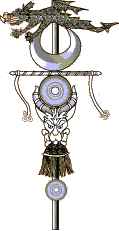
![]() It is known that the “draco” standards of the Roman Second Legion’s cohorts (stationed in Britain and Wales from 44 A. D.) were adopted by the Britons, probably as a metal (possibly real gold) head with a windsock type of body made of silk. In the mouth was a whistling type device that would make sounds as it was waved with vigor. Supposedly used by King Arthur, and certainly used by the Wessex lords in the 700s, the emblem has been used by Britons right up to the present time.
It is known that the “draco” standards of the Roman Second Legion’s cohorts (stationed in Britain and Wales from 44 A. D.) were adopted by the Britons, probably as a metal (possibly real gold) head with a windsock type of body made of silk. In the mouth was a whistling type device that would make sounds as it was waved with vigor. Supposedly used by King Arthur, and certainly used by the Wessex lords in the 700s, the emblem has been used by Britons right up to the present time.
![]() Today the dragon is the most prominent Welsh symbol. It is an ancient symbol, already prominent across England and Wales in the years after the departure of the Romans. With the invasions of the Angles and Saxons, the ancient Britons and their dragon symbol were pushed back towards Wales.
Today the dragon is the most prominent Welsh symbol. It is an ancient symbol, already prominent across England and Wales in the years after the departure of the Romans. With the invasions of the Angles and Saxons, the ancient Britons and their dragon symbol were pushed back towards Wales.
![]() The various distinctions of the helmet in heraldry were introduced after the Restoration. The reader need not be concerned with them — because the imagery of the Rhys coat-of-arms predates the Restoration by eleven centuries! Here, the interesting point is the presence of crosses on the cheeks — in Celtic imagery, the cross expresses the unity between heaven and earth, their reconciliation and reintegration by the Passion, Death, and Resurrection of Jesus Christ, our Lord. The cross is borne on the arms of those who valiantly participated in the Crusades — and the wars with infidels such as the pagan Picts, Scotts, Irish, Angles, Saxons, Jutes, Danes, and Norsemen. This was certainly the case with the Rhys family, who as Catholic princes even well before before the fall of the Roman Empire met the obligations of their office by repulsing the onslaughts of heathen kings bent on settling their restless warriors, and imposing their idolatrous religious systems, in Britain.
The various distinctions of the helmet in heraldry were introduced after the Restoration. The reader need not be concerned with them — because the imagery of the Rhys coat-of-arms predates the Restoration by eleven centuries! Here, the interesting point is the presence of crosses on the cheeks — in Celtic imagery, the cross expresses the unity between heaven and earth, their reconciliation and reintegration by the Passion, Death, and Resurrection of Jesus Christ, our Lord. The cross is borne on the arms of those who valiantly participated in the Crusades — and the wars with infidels such as the pagan Picts, Scotts, Irish, Angles, Saxons, Jutes, Danes, and Norsemen. This was certainly the case with the Rhys family, who as Catholic princes even well before before the fall of the Roman Empire met the obligations of their office by repulsing the onslaughts of heathen kings bent on settling their restless warriors, and imposing their idolatrous religious systems, in Britain.
![]() The Rhys family were architects and builders. The castle commemorates the many fortifications which they constructed — or conquered outright. Castles are emblems of safety, security, indomitability, constancy, and fidelity.
The Rhys family were architects and builders. The castle commemorates the many fortifications which they constructed — or conquered outright. Castles are emblems of safety, security, indomitability, constancy, and fidelity.
CAUTION!
![]() In general it is fruitless to try to determine “the” meaning of a specific coat-of-arms. Coats-of-arms were, for the most part, freely adopted by individuals at some point in the Middle Ages or later. In almost all cases, it is impossible to say what meaning, if any, they saw in the arms they adopted. Even in the case of grants-of-arms, it is usually not known who designed the arms (the recipient or the royal herald) and what either had in mind.
In general it is fruitless to try to determine “the” meaning of a specific coat-of-arms. Coats-of-arms were, for the most part, freely adopted by individuals at some point in the Middle Ages or later. In almost all cases, it is impossible to say what meaning, if any, they saw in the arms they adopted. Even in the case of grants-of-arms, it is usually not known who designed the arms (the recipient or the royal herald) and what either had in mind.
![]() But . . .
But . . .
![]() There are exceptions, of course. For example, there are cases where an anecdote, true or legendary, is attached to the origin of a coat-of-arms. Also, for the most prestigious and important coats-of-arms, such as those of kingdoms, legends built up over their origins, and symbolic meaning was attached to them as well.
There are exceptions, of course. For example, there are cases where an anecdote, true or legendary, is attached to the origin of a coat-of-arms. Also, for the most prestigious and important coats-of-arms, such as those of kingdoms, legends built up over their origins, and symbolic meaning was attached to them as well.
![]() The regulation of English heraldry between 1530 and 1688 has led many writers (incorrectly) to project back into the Middle Ages concepts and beliefs of later times. In particular, one often sees the claim made that, in Medieval England, arms were restricted to the knightly class, or at least to the gentry. Furthermore, by equating gentry with nobility, some writers wrongly reach the conclusion that arms were restricted to the nobility.
The regulation of English heraldry between 1530 and 1688 has led many writers (incorrectly) to project back into the Middle Ages concepts and beliefs of later times. In particular, one often sees the claim made that, in Medieval England, arms were restricted to the knightly class, or at least to the gentry. Furthermore, by equating gentry with nobility, some writers wrongly reach the conclusion that arms were restricted to the nobility.
![]() Prior to the 16th century, heraldry was unregulated in England, just as it was unregulated in all European countries. No laws or institutions prevented anyone from adopting arms as they pleased. Heraldry spread from the noble and knightly class to the merchant, craftsmen and farming classes from the 14th century on.
Prior to the 16th century, heraldry was unregulated in England, just as it was unregulated in all European countries. No laws or institutions prevented anyone from adopting arms as they pleased. Heraldry spread from the noble and knightly class to the merchant, craftsmen and farming classes from the 14th century on.